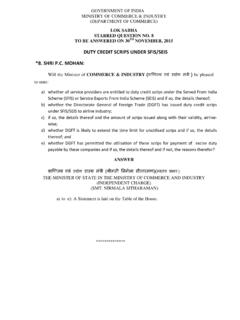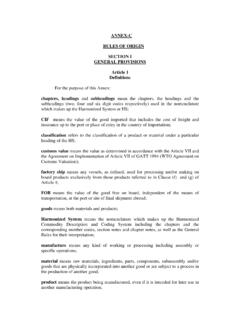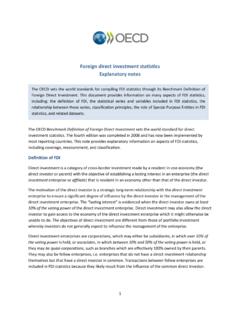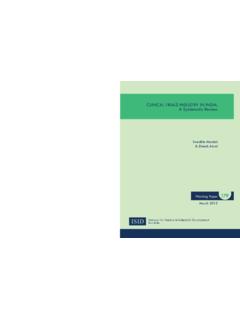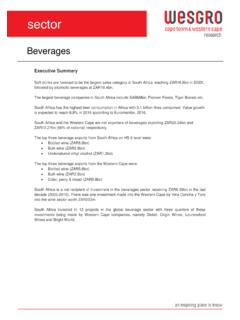Transcription of India's Strategy for Economic Integration with CLMV
1 India's Strategy for Economic Integration with CLMVDr. RAM UPENDRA DASD epartment of Commerce Ministry of Commerce and Industry Government of IndialR;eso t;rsIndia s Strategy for Economic Integration with CLMVI ndia s Strategy for Economic Integration with CLMVbyDr. Ram Upendra DasDepartment of CommerceMinistry of Commerce and Industry Government of IndialR;eso t;rsAll rights served. No part of this publication may be reproduced, stored in a retrieval system, or transmitted, in any form or by any means, electronic, mechanical, photocopying, recording or otherwise, without prior notice to or permission from the : 81-7122-109-2 Department of CommerceMinistry of Commerce and Industry Government of IndiaNew Delhi 2015 ContEntSForeword by Shri Rajeev Kher, Commerce Secretary, Government of india .
2 ViiAcknowledgements ..ixExecutive Summary ..xiChapter 1: Introduction ..1 Chapter II: Why CLMV?: Rationale for Economic Integration between india and CLMV ..5 Chapter III: Where cooperation?: Potential Goods, Services and FDI Sectors with complementarities ..21 Chapter IV: How?: RVCs-Stages of Production in Identified Sectors Relevant for india ..25 Chapter V: Integrated Approach: Trade in Goods & Services and O-FDI in RVCs ..31 Chapter VI: Challenges in the Existing Scenario ..37 Chapter VII: Insights gained from Stakeholders Consultations ..41 Chapter VIII: What and How of Cooperation?: Policy Strategy and Recommendations-RVCs and an Integrated Approach ..45 References ..55 Annexures ..57 Room No. 143, Udyog Bhawan, Tel.: 23063664 / Fax: 23061796 / E-mail : is immensely grateful to Mr. Rajeev Kher, Commerce Secretary, Government of india for getting this study initiated.
3 Important insights received from Mr Ravi Capoor, Joint Secretary and Ms. Amrit Raj, Director, Ministry of Commerce and Industry, GOI are gratefully acknowledged. The study benefitted from valuable discussions during the Inter-Ministerial Meetings convened by the Commerce Secretary on 8 July 2014 and 10 March 2015 in New Delhi including the submissions made by stakeholders and Ministries. Thanks are also due to Ms. Gamika Takkar for sincere research support, as well as Ms. Nitya Batra at the final stages of the study. The funding received from the Ministry of Commerce and Industry, GOI is also gratefully acknowledged. Thanks are also due to Mr. Tish Malhotra and Mr. Sachin Singhal for publication-related valuable technical support. However, usual disclaimers why CLMV?
4 : Rationale for Economic Integration between india and CLMV Greater headroom for establishing commercial and Economic linkages: Since CLMV are lesser developed economies, characterized with untapped potential for development, they offer more scope for scaling up Economic linkages with india . They have also displayed tremendous GDP and GDP per capita growth dynamism in recent years. The development divide between the CLMV region and the rest of the ASEAN region is also evident. Thus, a better understanding of CLMV economies is needed, also as their developmental challenges are similar to india . Imperatives of Economic cooperation are even more pronounced due to locational proximity with india . These also reflect in lower transportation costs and time. Cheap labour cost advantage in CLMV, open trade and FDI policy regimes and gradually improving infrastructure make CLMV an ideal setting for india to harness the untapped Economic potential that may exist in these countries.
5 CLMV are keen to collaborate with india also due to the fact that they do not get adequate support from other ASEAN members this could be helpful in india s negotiations in RCEP ASEAN+6 etc. as they look up to india for leadership. Despite these advantages, the present india -CLMV Economic linkages, both in trade and FDI, are considerably weak. On the other hand, the major multinationals are already present in CLMV and there is a downside risk that india may miss the bus in terms of harnessing perhaps the last opportunity in terms of labour-cost arbitrage. There are several sectors in CLMV that have been identified as focus sectors by the CLMV governments such as agro-processing, oil and gas, pharmaceuticals, wood and timber, light engineering, garments, automobiles, education, IT, SMEs, tourism, skill development.
6 These need to be taken cognizance SummaryIndIa s Strategy for Economic Integration with cLmVxii It has also been found that one of the most important ingredients of setting up business is skill availability and there exists considerable skill complementarity between india and CLMV in terms of skill availability in india matched with unavailability in where Cooperation?: Potential Goods, Services and FDI Sectors with Complementarities Various methodologies have been used to identify potential sectors for cooperation and building RVCs between india and CLMV. These include Dynamic RCA, Intra-Industry Trade, Cosine Index, Stakeholders Consultation, and secondary material. In doing so, by combining goods, services and FDI, an integrated approach is adopted. Potential sectors in goods trade and manufacturing are identified as Textiles and Garments, Processed Food, Electrical and Electronic Equipments, Pharmaceuticals, Gems and Jewellery, Marine and Seafood, Oil and Natural Gas, Automobile parts, Iron and Steel, Articles of Iron and Steel, Leather and Rubber and Rubber articles.
7 Potential sectors in trade in services are identified as Software and ICT Services, Telecommunication services, Capacity Building, Agri-Diagnostic services, Health, Financial services, Professional Services, Education, Transport , Tourism and Travel Related Services. Potential sectors for india s Outward- FDI (O-FDI) are identified as Marine Sector, Agriculture, Electrical and Electronic Equipments, Pharmaceuticals, Petroleum, Automobiles, Steel, Leather, Gems and Jewellery and Textiles and Garments. These together provide the basis for combining the sectors from goods, services and O-FDI into one whole integrated framework. The question where india could fit into the value chains was also identified through specific stages of production. III. Challenges in the Existing ScenarioSome of the major challenges confronting the india -CLMV Economic relations include: Information gap Asymmetric Inconsistent Inadequate Communication gap: limited interactions at various levels Integrating SME in RVCs Banking constraints Capacity building/Skill development Technical support Facilitating O-FDI Infrastructural constraints-Physical/Digital/softIV.
8 What and How of Cooperation?: Policy Strategy and Recommendations-RVCs and an Integrated ApproachThe underdevelopment of CLMV is a developmental opportunity for india is the backdrop in which this study has provided sufficient rationale for Economic Integration between india and the CLMV region. In doing so, the study has found that the present levels of Economic linkages including trade and investment between the two remain weak and low. On the other hand, the study finds ExECuTIVE SuMMAR yxiiienormous potential for a more heightened Economic Integration between india and the CLMV region in the domains of trade in goods, trade in services and FDI. Not only the sectors have been identified for this purpose in the study, they have also been placed in an Integrated Framework to enhance trade and investment flows as well as to tap skill complementarities so that regional value chains between india and CLMV could be created and strengthened.
9 The study also finds that while there are enormous challenges that may have to be addressed, one of the important ways of utilising the CLMV s Economic space is by setting up manufacturing units in the region and access the Chinese markets through exports originating from CLMV under the China-ASEAN FTA. Given these, a summary of findings of the study for creating potential RVCs is presented in Table the light of broad concluding insights that the study presents, some broad contours of india s Strategy for Economic Integration with the CLMV region are presented by way of Policy Recommendations. They are divided into two parts, viz. theme-specific and horizontal. For theme-specific recommendations one may refer to Table Horizontal Policy Recommendations Creating india -CLMV Convergence of Interests in Regional trade negotiations: india must engage CLMV as it wants india to play a more pro-active role.
10 This is because these countries often do not get their voices heard in the ASEAN Caucus. Therefore, india -CLMV relations could be important bedrock for even the RCEP negotiations where india can get support from these countries. Regional Value Chains (RVCs): Given the backdrop of india s participation in RVCs being relatively low and the fact that RVCs are not well-developed in CLMV, one of the prime strategies for india s Economic Integration with CLMV region is to create RVCs. This is in contrast to the fact that RVCs have huge presence in ASEAN. Regional value chains entail relocation of production bases at different stages of production and manufacturing in different countries that are linked with services. The net outcome of such relocation is in terms of efficiency-seeking industrial restructuring.





